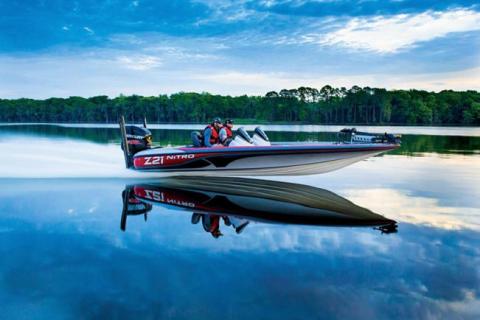
Would you like to save fuel, get on plane faster, and beat your competition to the best fishing spots? Thought so. All boat owners can benefit from knowing a few boat propeller basics, but prop terminology has a tendency to sound an awful lot like math. That’s probably why many of us simply run the prop that's delivered with our boat.
 |
| Correct prop diameter and pitch ensures that your fishing boat will plane quickly and reach top speed—allowing you faster access to your favorite spots. |
The basics aren’t that hard to master, and physics is a lot more fun when we apply it to boating. Not only will you be able to optimize your boat’s performance, you’ll sound a heck of a lot smarter the next time you pull up to the marina. Here's an easy primer to help “prop” up your knowledge.
The Propeller Diameter Factor
Diameter is the width of the circle made by the tips of the blade in a complete turn. If you own a big boat, large diameter propellers will typically be your best bet as they are good at carrying heavy loads. Owners of lighter boats will want to stick to small diameter propellers to achieve maximum speeds.
How Props Affect Slip
Here’s a technical term that will help you impress your buddies at the ramp. Slip is the loss of efficiency that results with a prop turning through a liquid medium compared to the efficiency it would have turning through a theoretical solid. Light, fast boats with performance stainless steel props—such as bass boats— typically show around 10 percent slip when set up perfectly. Heavier, deeper boats will have greater slip— some 25 percent or more.
How Propellers Affect Pitch
The pitch is the distance a prop would travel through the water in a complete turn if there were no slip. High pitch propellers are good at pushing boats faster, provided horsepower is adequate. Low pitch propellers help heavier boats reach recommended maximum rpms and also improve holeshots—the time it takes for a boat to achieve plan from a dead stop at maximum throttle.
For an increase of 1 inch in pitch, most propellers drop engine revs by 150 to 200 rpms. For example: if your engine is rated to turn 6000 rpms and it's turning 6300 with a 23" pitch prop, you can put it back into the safe rpm range by going to a 25-incher of the same design. You’ll also gain a bit of speed, but gains are typically in the one to three mph range. Larger jumps are unlikely without tweaking engine mounting height and setback.
The Boat Propeller Blade Area
Blade area also affects propeller performance. Four-blade props have more area than three-blade propellers. This additional area can provide an increase in lift on holeshots and is useful in getting stern-heavy boats on plane. Four-blade models are typically not as fast as three-blades props. Three-blade propellers usually present the best combination of holeshot, mid-range acceleration, and top end speed.
Types of Propeller Material
Aluminum propellers like those from PropCo are cost effective but lack durability and the necessary blade strength to be cast in complex forms that increase top-end performance. They're fine on boats designed to run up to 40 MPH, and also make great spare props to help you get home.
Stainless steel propellers like those from Mercury and other manufacturers cost three to five times more than aluminum props but are likely to last many times longer even with rough use. The strength of stainless steel also allows complex blade shapes to be cast very thin. This assures better performance, particularly at top end speeds.
Mercury Marine offers an on-line prop selector that eases propeller choice. See it here: www.mercurymarine.com/en/us/propellers/selector/#/step-one
- 11962 views

